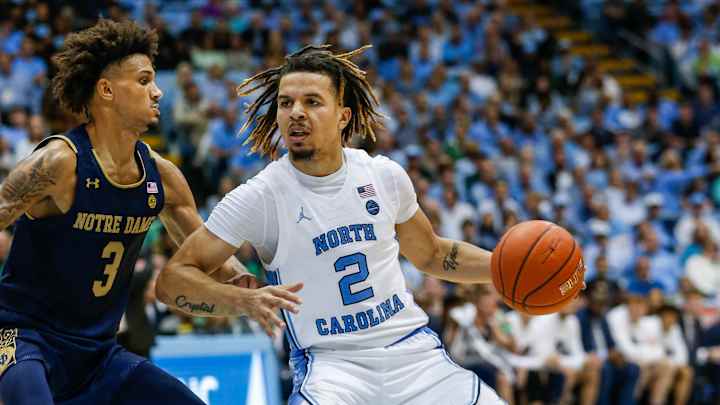Is Cole Anthony's Defensive Rebounding Hurting the UNC Fast Break?

Unprompted, Roy Williams began addressing a topic that had come up among North Carolina fans in recent days after another double-figure rebounding effort from Cole Anthony.
Was the point guard’s willingness and ability to attack the defensive boards keeping the Tar Heels from getting out on the break?
Williams went back to the 1980’s to draw a comparison to the Los Angeles Lakers’ Showtime era, when a 6-9 point guard named Magic Johnson — who averaged 7.2 rebounds over his career — had the ability to get things moving on his own.
“I always thought their best fast-breaks were when Magic got the rebound because then there was no outlet pass, there was no catching and turning and all that,” he said. “You just get the ball and you bust out, so Magic left two of the opponents behind and sometimes three behind in the first five or 10 feet.”
The logic is pretty easy to follow. A point guard grabs and goes, rather than wasting valuable seconds looking for an outlet, making the pass then turning to assess what’s ahead.
For a coach that wants to play as fast as humanly possible, a perfect world would be five players who can lead the break, but for now, he'll allow any perimeter player with the ability to ignite the offense.
So, when the topic of whether a point guard crashing the boards too hard could be a negative for Carolina’s all-around defense, Williams was bewildered.
“I could give a blankety-blank what some analytics say,” he said. “I watch the freaking game and our point guard has 21 defensive rebounds. You think I care about one basket? Tell the analytics, no never mind; God almighty.”
The reality is that Carolina isn’t getting on the break less than usual; it’s just been less effective than recent teams at converting baskets in transition.
In fact, according to Hoop-Math.com, the Tar Heels have actually gotten more transition opportunities in their first two games this season (41.2 percent) than they averaged last season (40.1 percent).
Per Hoop-Math, transition shots are defined as attempts within the first 10 seconds after a steal, defensive rebound or an opponent’s basket.
In particular, Carolina has actually gotten more fast-break opportunities off defensive rebounds this season, with 30.7 percent of its transition opportunities coming off boards vs. last year’s 23.5 percent.
The discrepancy comes on live-ball turnovers — the steals that truly shift the momentum of a game and lead to exciting transition opportunities. Last year, the Tar Heels got 6 percent of their fast-break opportunities with a shot attempted within 10 seconds of a steal, and another 2 percent 11 or more seconds after a steal.
Through two games this season, just 3.5 percent of transition opportunities come immediately after a steal and none after that.
That tracks with Carolina’s inability to force turnovers this season, where it ranks 344 of 351 teams, having forced turnovers on just 11.4 percent of defensive possessions.
All of that is compounded by poor — relative to Carolina’s history — performance on the break, where it’s shooting jut 50 percent on attempts at the rim, 27.7 percent on 2-point jumpers and 31.2 percent on 3-point attempts.
Last season, Carolina made 69.8 percent at the rim, 40.2 percent on 2-point jumpers and 32.1 percent on 3-point attempts.
To wrap all of that up, no, Anthony’s rebounding isn’t hurting Carolina’s fast-break at all.
Instead, the Tar Heels haven’t had nearly as many sure-thing breaks because of their inability to force turnovers, and on the times they have gotten on the break, poor shot quality and missed shots have been the culprit.
If anything, Anthony’s rebounding means the Carolina break could be just as good as ever, provided it finds a way to start getting steals and taking — making — better shots.
Williams has no doubt he’s got the best point guard he’s ever seen do it at the high school level, and so far, returns are pretty darn good in the ACC.
“There have been some guards that have been good rebounders, but for a point guard, Cole does it better than anybody,” he said. “He goes and gets it and that’s the biggest thing; you’ve got to go and put yourself in that position and he’s not afraid to go in and mix it up with the bigger guys. He does have the strength and the jumping ability to go in there and compete for it, but he bids on everything.”
He’s also certain that Anthony’s unique skill is nothing but a positive.
“You know the reason we don’t have our break is the other freaking guys aren’t running enough,” Williams said. “It’s not Cole going to rebound, Jesus Christ.”
